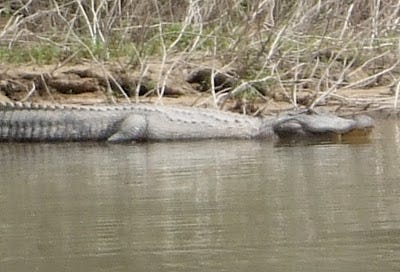Gator Country
Expert: Alligators living in the Lampasas River likely have been here for decades
An American alligator stands in shallow water alongside a bank in the Lampasas River upstream from Stillhouse Hollow Reservoir. Experts say a small number of gators live in the Lampasas and likely have for a long time. Courtesy photo
DAVID STONE | OUR TOWN TEMPLE
A small but healthy population of American alligators live on the Lampasas River above Stillhouse Hollow Reservoir, and Texas alligator experts say they’ve likely lived there for decades if not centuries.
“I’m not sure how many alligators live in the Lampasas, but there are a few,” said Jonathan Warner, alligator program leader for Texas Parks & Wildlife.
“Gators living in the Texas Hill Country are rare, but they do exist. This is the extreme western fringe of their range,” he said. “Down in southwest Texas along the Rio Grande, you have a few, but the Lampasas alligators are about as far west as this species goes.”
Warner said the gators likely have been here all along but now humans and wildlife are crossing paths at an unprecedented rate.
“It’s not a case of alligators moving into our habitat, it’s the other way around,” he said. “More and more people are moving to Central Texas, and as a result, humans are expanding into their world. There will be more encounters in the future. Their numbers are not rapidly expanding, we’re just bumping into them more frequently.”
“Alligators are native to the Lampasas River watershed,” he said. “They must have a den somewhere to survive cold weather.”
Warner said both Stillhouse Hollow and Lake Belton have habitats that are perfect for alligators to call home, but he said all reported encounters have been on the Lampasas River.
Bob Maindelle, an avid fisherman and owner of Holding the Line Fishing Guide Service, said he has personally seen gators on the Lampasas.
“I’ve seen them — they are there,” Maindelle said during a recent interview. “I saw one just upriver from Stillhouse, but I’ve never seen or heard of alligators in Lake Belton.”
TP&W Game Warden Chris Sanchez, who is based in Temple, said there have been two incidents of alligators being illegally killed in Bell County since 2016.
“There were two taken illegally — a big one in 2016 and a six-to-eight-foot gator in 2021,” Sanches said. “We’ve gotten a few calls, but we have frequent conversations about the Lampasas River alligators. This is a known area for the native species, but they are seldom seen. We know they live in the Lampasas River corridor.”
In 2016, two fishermen were charged in the killing of an 11-foot gator in the Lampasas, just west of Stillhouse. The men were fishing for catfish when the alligator hung itself on a hook. The men said they euthanized the animal before calling a TP&W hotline.
Bell County is a non-core alligator hunting county, meaning only one alligator can be harvested per person during a season that runs from April 1 to June 30. Hunters must have a permit and can only harvest gators on private property.
If a person encounters an alligator, Warner said the best plan of action is to leave it alone and move out of the area.
“Don’t feed it,” he said. “If it’s fed, it’s dead.”
Alligators that are fed by humans begin to associate food with people, which could lead to an ugly outcome. In locations where gators are common and human/alligator interactions occur on a regular basis, a fed alligator will become aggressive and the animal must be destroyed.
Sean Jones, lake ranger and natural resource specialist at Stillhouse Hollow, said the alligators seldom venture into the lake.
“There’s a few of them out there, we’ve seen probably three,” he said. “They stick to the river and tend to stay away from people. A lot of folks fish and kayak in the Lampasas, and the alligators just keep to themselves.”
“To my knowledge, there have been no incidents of aggressive behavior by the alligators,” Jones said. “It’s absolutely safe to fish and boat in the Lampasas.”
What’s up, Central Texas?
I hope you have enjoyed my offerings this week. I want to express my appreciation to the many readers who have used the “tip jar” button to help support community journalism. Thank you. If you value my journalism, please show your support:











